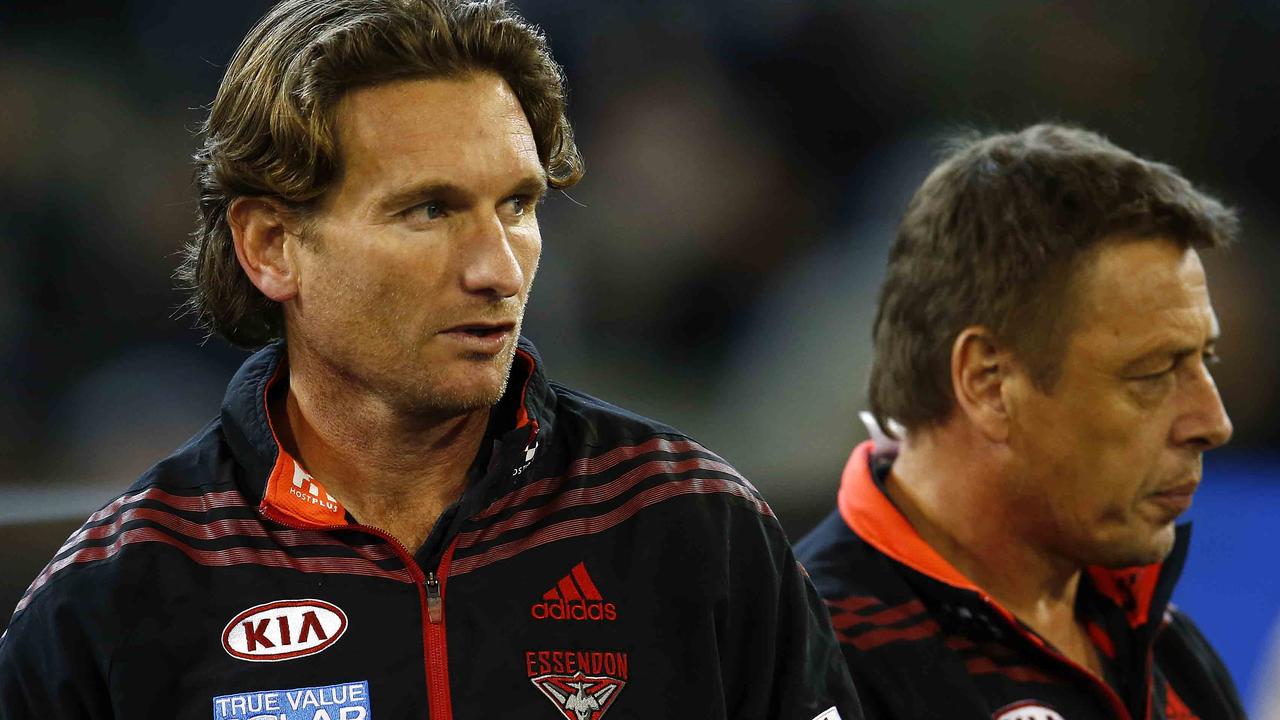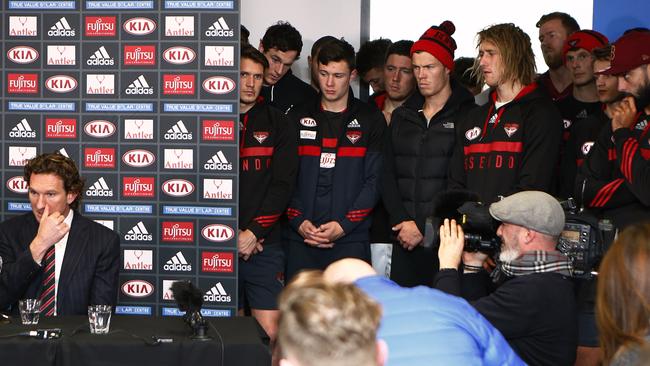James Hird’s father calls on former Essendon chairman David Evans to break silence on supplements saga
James Hird’s father has called for a key Essendon figure to break his silence on the ‘fatal mistake’ that changed the course of the supplement saga.
AFL
Don't miss out on the headlines from AFL. Followed categories will be added to My News.
James Hird’s father has challenged former Bombers chairman David Evans to come clean on the biggest secret of the Essendon doping saga.
Evans has never spoken publicly about the club’s critical decision in February 2013 to “self-report” the use of supplements during the 2012 season to the AFL and Australian Sports Anti-Doping Authority.
“From that point on James Hird was embroiled in events that caused his separation from the game he loved, Australian football, and the club he had followed since birth,” Allan Hird said this week.
Evans came forward on Tuesday, February 5, 2013 – just days after AFL chief executive Andrew Demetriou, his deputy Gillon McLachlan and league integrity boss Brett Clothier attended a secret briefing with the Australian Crime Commission in Canberra.
“Andrew Demetriou was spooked and he spooked David Evans,” Hird Sr said.
“But while Andrew Demetriou had a plan, David Evans had none; except of course to be Andrew Demetriou’s puppy and obediently follow him.
“The most puzzling conundrum is that the Essendon board, under David Evans’ chairmanship, accepted without proof something wrong had occurred in 2012; namely the club may have allowed players to be administered substances prohibited under the world anti-doping code.
“That was a fatal mistake in that, from the get-go and before any investigation, the club’s actions were predicated on managing a situation where guilt was assumed.”

Essendon’s critics insist the club’s fate was sealed when sports scientist Stephen Dank began injecting players with unknown substances, but Hird Sr said the players’ ability to defend themselves from claims of cheating were lost when Evans sided with Demetriou.
“Instead, the board under David Evans’ leadership supported the AFL’s manufactured outcome,” he said.
“That outcome was supposed to see the players escape penalty and support staff charged and punished. But, as we know, the players were wrongly convicted at the Court of Arbitration for Sport and their careers ruined when the AFL suspended them for the2016 season.
“What they did to 34 young men is up there with what the justice system did to Lindy Chamberlain.
“If only David Evans had not trusted Andrew Demetriou but listened to the club coach and the club doctor and let ASADA runan independent investigation.
“But that was not to be. David Evans and the Essendon board went along with and assisted
the AFL in involving itself directly in the investigation as to whether prohibited substances
had been used at Essendon.”
The decision by the Dons board to commission a review of the club’s governance failings authored by Ziggy Switkowski was another act of betrayal, Hird Sr said.
“Why commission a review and release it to those investigating you when it can only do harm? The media, fed by the leaks from the AFL/ASADA joint investigation, became hysterical; even camping on the coach’s door step on a daily basis just to feed the daily TV news,” he said.
“From that point on there was an inevitability about the final outcome. Expectations of wrongdoing had been built up so far that the Essendon players were never going to be cleared. No matter if there was no evidence, only guilty verdicts would satisfy. The Court of Arbitration for Sport met that expectation.
“And the part played by David Evans throughout 2013 until his resignation on 27 July 2013 is still hidden in secrecy. He concluded his resignation statement with this: ‘I will make no further comment until further notice’. He has been true to his word.
“It’s time for David Evans to speak up, but don’t hold your breath.”

Hird Sr said it was extraordinary the Essendon board chose to recognise Evans with life membership in 2019.
“That’s right, the man who was the AFL’s lieutenant in the events that led to the Essendon players being denied the right they had earned to play in the 2013 finals and saw 34 of them banned by the AFL for the 2016 season, was awarded life membership,” he said.
“The Essendon board has learnt nothing.”
Evans was contacted by the Herald Sun but did not return calls.
Sample destruction eliminates certainty over Dons injections
Blood and urine samples taken from Essendon players during the 2012 AFL season will be destroyed after being stored for a decade in a secure Sydney laboratory.
The Australian Sports Anti-Doping Authority hoped to test the samples for traces of the banned peptide Thymosin Beta-4 as drug testing technology advanced — but laws forbid authorities from keeping the samples after 10 years.
Sports Integrity Australia, which took charge of the now defunct ASADA two years ago, confirmed samples taken from athletes can only be stored for 10 years under the World Anti-Doping Code.
The window on Essendon’s 2012 samples closed late last year.

Asked whether anti-doping authorities had been reanalysing the samples taken from Bombers players, an SIA legal spokesman said: “Sport Integrity Australia is unable to comment due to the secrecy provisions outlined in section 67 of the Sport Integrity Australia Act 2020.”
The likely destruction of the samples means it will never be known for certain whether TB4 was administered to Dons players under a program run by sports scientist Stephen Dank during the club’s ill-fated 2012 season.
The absence of a specific test to detect the presence of TB4 in athletes was a major weakness in the case against 34 Essendon players rubbed out for doping by the Court of Arbitration for Sport in 2016.
‘Massive cover-up’: Last-ditch bid to clear Essendon 34
A last-ditch bid to clear the names of 34 Essendon players wiped out for doping has been made in a Queensland tribunal.
The Administrative Appeals Tribunal in Brisbane is set to rule on whether a batch of secret anti-doping agency documents relating to the Bombers case will be released under Freedom of Information laws.
Sports Integrity Australia — which replaced the Australian Sports Anti-Doping Authority two years ago — is fighting to deny public access to documents presented to an independent government panel at a critical stage of the suspension process in 2014.
And the Herald Sun can reveal Essendon and the AFL have supported SIA in its attempts to prevent the release of the documents to economist and former Australian Test cricketer Bruce Francis.
“The Essendon members and general public should be enraged to know that the AFL and the club are still involved in a massive cover-up,” Francis said.
In a letter to the AAT in December 2021, former Bombers chief executive Xavier Campbell said: “In accordance with our understanding of the wishes of the vast majority of the 34 players who were issued with show cause notices, the Essendon Football Club does not consent to the disclosure of the information in the documents”.
Campbell did consent to the disclosure of information relating “solely and specifically” to Nathan Lovett-Murray — “and not to any other past or present EFC player” — because the banned Bomber had provided written consent to SIA.

AFL integrity chief Tony Keane warned in an affidavit that the AFL might need to cut ties with SIA if the documents were released.
“In my view, the AFL would likely consider withdrawing from the current agreement as it would consider that SIA is no longer capable of meeting its obligations,” Keane said.
One of late billionaire Kerry Packer’s most trusted lieutenants during the establishment of World Series Cricket, Francis, 74, has devoted 10 years to exposing “the corruption and injustice” of the Essendon drugs investigation.
The documents being sought were used as the basis of an ASADA pitch to the federal government-appointed Anti-Doping Rule Violation Panel on November 3, 2014.
The ADRVP – made up of experts in sports medicine, sports law, clinical pharmacology, ethics and investigations – was tasked with deciding whether ASADA had built a strong enough case to trigger the serving of infraction notices on the Essendon 34.
The panel agreed to place the accused players on a register of findings, leading to a hearing before an AFL anti-doping tribunal, which initially cleared them of wrongdoing.
But on January 12, 2016, the Court of Arbitration for Sport overturned the verdict on appeal to find the 34 Bombers guilty of cheating.

The CAS concluded it was comfortably satisfied that the players had been repeatedly injected with the prohibited substance Thymosin Beta-4.
Francis says the release of the ASADA documents presented to the ADRVP would reveal how “highly misleading and fabricated evidence” was used in the doping agency’s pursuit of drug convictions.
“In June 2016, I sought access to two documents – the ASADA CEO recommendation show cause pack and the notes used at the ADRVP meeting on November 3, 2014 making the case that it was possible that 34 players were administered the alleged prohibited substance Thymosin Beta-4,” Francis said.
“On three occasions ASADA told me that the CEO recommendation show cause pack didn’t exist. When I proved it did exist, ASADA released a 90 per cent redacted copy. Subsequently, ASADA acknowledged it made 150-plus mistakes with its initial redactions.
“ASADA said it couldn’t release the November 2014 presentation notes because it contained private information.”
Francis appealed to the AAT, a hearing took place in December 2021 and all parties are awaiting a decision.
Originally published as James Hird’s father calls on former Essendon chairman David Evans to break silence on supplements saga




